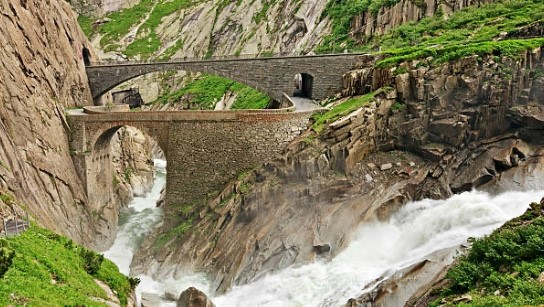WHEN THE EDELWEISS emerges from its snowy blanket in spring so too does the Andermatt Golf course. Over 1,400m above sea level, the fairways echo to the tinkle of cowbells and glacier-water tumbles down the slopes into clear streams. Every shot on this 18-hole par 72 championship course provides enchanting views of the valleys and encircling Alps. Some holes test the lungs, but the ball soars unbelievably far through the thin air.
Up until 1818 Andermatt was virtually inaccessible, prone to rockfalls and avalanches. Benedictine monks from the abbey across the pass called it “The Valley of the Devil.” In the ‘Flight of The Earls’ from Ulster in 1608, the last Gaelic Chieftains lost a fortune when their gold fell into the ravine as they attempted to cross the treacherous ‘Devil’s Bridge’ on St Patrick’s Day. ‘The Lost Treasure of The St Gotthard Pass’ has never been recovered.
When the St Gotthard railway tunnel was finished in 1881 Andermatt was bypassed completely, the line went underneath it. In the 20th century the Swiss army Alpine unit trained there, afterwards it became an alternative ski resort to its more expensive neighbours St Moritz and Gstaad.
Egyptian billionaire, Samih Sawiris committed £1.2billion to its regeneration and it has now become one of the most prestigious resorts in the Alps, with the Chedi Andermatt and Radisson Blu hotels providing 5* accommodation never dreamed of by the shivering monks. Consistently winner of Switzerland’s Top Course award, Andermatt is open on a pay and play basis. Holidaymakers can combine it with a treasure hunt for the lost gold.
AT AUGUSTA NATIONAL Rae’s Creek flows behind the 11th green and in front of the 12th in what is known as Amen Corner. The creek is named after Irish landowner John Rae, who built a fortress home there in 1734. Rae’s house was the farthest up the Savannah River from Fort Augusta, and neighbours would use it as a safe haven during Indian (sorry, Native American) attacks.
SIX OF THE LAST 13 winners of the Masters (three of them Phil Mickelson) have been left-handed. Apparently if you naturally hit a draw, you have more success at Augusta, because several holes require right-to-left tee shots. Lefties can hit a cut where right-handed players have to hit a draw, although the way Mickelson played when he won his three Masters, it probably wouldn’t have mattered which hand he used.
One of the most miraculous shots ever seen at Augusta was by lefty Bubba Watson, who was looking to be in deep trouble when he drove his tee shot into the trees on the sudden-death playoff with Louis Oosthuizen. Standing at almost a right-angle to the pin, and using a wedge, he punched the ball through a narrow opening between the pines then bent it on a seemingly impossible trajectory 162 yds down the fairway and on to the centre of the green. He admitted it helped playing left-handed. Perhaps Rory should try it.
A CHIPPING TIP from Pitch Perfect: Good chippers start with the shaft forward at address. This hinges the wrists and creates the angle required for a solid downward strike. After that they just have to maintain the angle through the swing. Do the same and you’ll make smooth, solid contact every time. (Oh yeah!)
SINCE THE FIRST Masters dinner was arranged by Ben Hogan in 1952 some pretty exotic meals have been served, like sushi (Matsuyama, 2022) or wild boar and elk (Mike Weir, 2004.) Tiger did go for cheeseburgers after his first win in 1998, but his choice went more upmarket with every Masters victory. The Brits went for more homely fare. Nick Faldo chose fish and chips and tomato soup and Danny Willett Sunday roast and crumble and custard. Bubba Watson said he wanted plain food; his idea of plain food is apparently chicken/peanut/banana wraps. Not sure what the yanks made of Sandy Lyle’s choice which was of course, haggis.
Until next time: Happy Golfing.
Contact Mick for regripping and repairs. 638 859 475.or visit https://mickthegrip.blogspot.com





